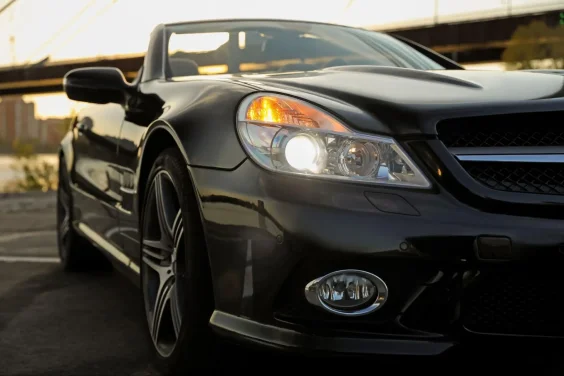Reading Time: 8 minutes
Hail damage can leave your car covered in dents and scratches, affecting both its appearance and value. While DIY repair kits might seem like a quick fix, professional hail damage repair ensures a better result and long-term protection for your vehicle. This guide explains how professional repair works and why it’s worth the investment.
This guide covers:
- When experienced technicians use paintless dent repair (PDR) and how it works;
- How panel replacement and refinishing restore severe damage;
- Why blending and finishing are essential for a seamless final look
Why Professional Hail Repair Matters
Hail damage is more than just an eyesore, if left untreated, it can reduce your car’s resale value and lead to bigger problems down the road. Even small dents can cause the paint to crack, exposing the metal underneath to moisture and eventually leading to rust and corrosion.
While there are plenty of DIY dent repair kits on the market, they often fall short when it comes to achieving professional-quality results. Here’s why professional repair is the better option:
DIY vs. Professional Hail Repair
| DIY Issue | Professional Solution |
| Poor paint match – DIY kits can’t replicate the factory color, leading to visible mismatches. | PPG MoonWalk – Automated paint mixing system ensures a perfect color match, even for custom finishes. |
| Risk of further damage – Improper dent pulling can warp the metal or crack the paint. | PDR Expertise – Technicians use specialized PDR rods and glue systems to gently reshape dents without damaging the paint. |
| Limited to small dents – DIY kits often can’t handle larger or more complex damage. | Panel Replacement – For severe damage, Pro-Masters replaces panels and refinishes them to factory standards. |
| Long repair time – DIY repairs can take hours (or days) and often need to be redone. | Fast Turnaround – PDR is often completed the same day; panel replacement takes 2–3 days. |
| No warranty or guarantee – If the repair fails, you’re out of luck. | Professional Guarantee – Pro-Masters’ work is backed by a satisfaction guarantee and insurance approval. |
Professional repair not only restores your vehicle’s appearance, it preserves its value and structural integrity. The combination of experienced technicians and cutting-edge tools like the PPG MoonWalk system ensures that your car comes out looking like it just left the factory.
Hail Damage Repair – Paintless Dent Repair (PDR)
Paintless dent repair (PDR) is one of the most effective and widely used techniques for fixing hail damage. It works by reshaping the metal panels from the inside, without needing to sand, fill, or repaint the surface. PDR is ideal for small to medium dents where the paint remains intact.
When PDR Works Best
PDR is most effective when the damage meets certain criteria:
- Small to medium dents (usually less than two inches in diameter)
- No cracks or breaks in the paint
- Damage is located on flexible panels like hoods, roofs, and doors
- Technicians can access the area behind the panel
How PDR Works
| Assessment |
| A technician evaluates the extent of the damage and confirms that PDR is suitable. |
| Accessing the Dent |
| The panel is carefully removed or opened to access the backside of the dent. |
| Reshaping |
| Using specialized PDR rods and glue-pulling systems, the technician gently massages the dented area back into its original shape. |
| Finishing |
| Once the dent is restored, the area is polished to remove any remaining surface imperfections. |
Why PDR is Preferred
| Benefit | Why It Matters |
| Preserves Original Finish | PDR maintains the factory paint job, which protects the car’s resale value. |
| Faster Turnaround | PDR repairs are typically completed within a few hours. |
| More Affordable | Since there’s no need for repainting or refinishing, PDR costs less than panel replacement. |
| Eco-Friendly | No need for paint or fillers reduces chemical use and waste. |
Hail Damage Repair – Panel Replacement and Refinishing
When hail damage is too severe for paintless dent repair, panel replacement is the alternative. Large dents, cracked paint, and distorted panels cannot be reshaped without affecting the structural integrity of the vehicle. In these cases, the best solution is to replace the damaged panel entirely and refinish it to match the rest of the car.
For example, if a hailstorm leaves the hood of a car covered in deep dents and the paint is cracked, PDR won’t work. The technician would remove the hood, install a new one, and repaint it to match the original color. This process not only restores the car’s appearance but also prevents long-term issues like rust and paint flaking.
How Panel Replacement Works
The process starts with carefully removing the damaged panel, taking care not to disturb surrounding parts or alignment points. Once the panel is off, the technician assesses the underlying structure for any hidden damage. If the frame is affected, it’s repaired or adjusted before the new panel is installed.
Next, the replacement panel, typically sourced directly from the manufacturer to guarantee an exact fit, is positioned and aligned. Proper alignment is critical to ensure that the panel sits flush with the rest of the body and that there are no uneven gaps or pressure points.
After the panel is secured, the surface is prepared for painting. This involves sanding and priming the panel to create a smooth, consistent base. At shops that have it, the PPG MoonWalk system is used to mix an exact color match based on the car’s original factory specifications. The new panel is then painted and clear-coated to ensure a uniform finish.
Finally, the car is polished and inspected under controlled lighting to confirm that the paint matches perfectly and that the panel alignment is seamless. This level of detail ensures that the repair is virtually undetectable and that the car’s original finish is preserved.
Hail Damage Repair – Blending and Finishing
Once the dent has been repaired or the panel replaced, the final step is blending and finishing. This step is essential for making the repair invisible and restoring the factory-quality look. Even a perfectly aligned panel or a well-executed PDR job can stand out if the paint finish isn’t seamless.
Blending ensures that the repaired area visually matches the surrounding panels under different lighting conditions. Color isn’t the only factor: texture and gloss also need to be consistent for the repair to be undetectable.
To begin, the technician lightly sands the edges of the repaired area to create a smooth transition between the new and existing paint. This allows the paint and clear coat to “feather” into the surrounding surface without leaving a hard line. Once the surface is prepared, the PPG MoonWalk system is used to generate an exact color match. The paint is applied in thin, controlled layers to avoid buildup or uneven texture.
After the paint cures, a clear coat is applied to protect the surface and create a uniform gloss. The technician then polishes the entire area using a fine-grit compound to remove any residual imperfections and ensure a mirror-like finish. This polishing process helps the new paint blend seamlessly with the original finish.
The final inspection is done under controlled lighting to ensure there’s no visible transition between panels. A well-blended finish should hold up under direct sunlight and indoor lighting, maintaining a consistent color and texture from every angle.
How a Quality Body Shop Handles These Steps
A body shop that knows how to handle blending and finishing properly will:
- Use an automated paint mixing system, like PPG MoonWalk, to ensure an exact color match;
- Perform a final inspection under multiple lighting conditions to check for consistency; and
- Polish and feather the edges to create a smooth, seamless transition.
Hail Damage Repair Frequently Asked Questions
Hail damage repair can feel overwhelming, especially when it comes to cost and repair time. Here are answers to some of the most common questions about professional hail damage repair:
| Question | Answer |
| How long does hail repair take? | Most PDR repairs are done the same day. Panel replacement and refinishing typically take 2–3 days. |
| Will my insurance cover hail damage repair? | Yes, most comprehensive auto insurance policies cover hail damage. Preferred services providers like Pro-Masters handle the claims process directly to make it easier for you. |
| What if the damage is too severe for PDR? | If PDR isn’t an option, panel replacement and refinishing will restore the car’s condition. A technician will assess the damage and recommend the best approach. |
| What happens if I leave hail damage untreated? | Over time, the paint may crack, exposing the metal underneath to rust and corrosion. This can lead to more costly repairs down the road. |
| Can I drive my car before it’s repaired? | Yes, but untreated dents and cracks could worsen with exposure to weather and road vibrations. It’s best to repair hail damage as soon as possible. |
Next Steps
Repairing hail damage isn’t just about restoring your car’s appearance. It’s about preserving its value and protecting it from long-term issues like rust and structural weakness. Professional techniques like paintless dent repair and panel replacement ensure that the job is done right while maintaining the car’s original finish and structural integrity.
Now that you understand how hail damage repair works, the next step is to trust a qualified team to handle it. Pro-Masters Auto Collision and Hail Center has over 30 years of experience in hail repair and is trusted by major insurance providers like GEICO. Our technicians use state-of-the-art tools, including the PPG MoonWalk system, to ensure a perfect color match and factory-quality finish.
If your car has hail damage, don’t wait for it to get worse. Call Pro-Masters Auto Collision and Hail Center today at 719-652-8897 or use our contact form to schedule your free evaluation.






